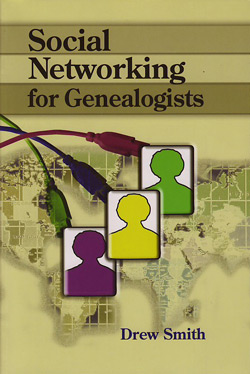Book Review: Social Networking for Genealogists, by Drew Smith.
This book is about the social networking made possible by the development of the Internet, and the ease of participating in  the the various interactive sites, some specific to genealogy, others not, without having to be a computer expert or even have much technical expertise whatsoever.
the the various interactive sites, some specific to genealogy, others not, without having to be a computer expert or even have much technical expertise whatsoever.
The 128-page volume is intended to identify those kinds of social networking sites and services that will be of the most interest to genealogists, all laid out in fourteen easy-to-understand chapters. The author also ends each of those chapters with a handy to-do list, helping the reader to follow up on what they learned in that section.
Following his Chapter One Introduction, The author, Drew Smith, deals with RSS feeds. This makes a lot of sense, as most genealogists use feeds to alert them to items of interest. He gives step-by-step instructions on setting up the RSS feed on the computer – a good start for the readers – as many folks are confused by this aspect. Chapter Three deals with tags, descriptive words that make it easy for both the author and the reader to find relevant information at any time after posting. Note that the most prominent tags on GenealogyBlog are the Categories – found in the right-hand column.
In Chapter Four, Drew explains Message Boards and Mailing Lists – methods of data sharing that predates most of what we think of today as Social Networking. GenForum, with over 14,000 online genealogy forums, was created in 1997, and is still heavily used, although owned by The Generations Network, and not really advanced technologically over what it was. TGN also launched their own Ancestry message boards which have more social networking features, and Drew rightfully gives these boards more space in his book. Mailing Lists have few social networking features, but are still a solid method of exchanging information, and are adequately covered in this chapter. Rootsweb hosts over 30,000 genealogical mailing lists, giving some idea of how important this method of communication is.
And then come blogs… Chapter Five deals with blogs, and their place in social networking. Drew mention’s Ralph Brandi’s early Geneablogy site, which he launched in February of 2000. He also mentions Steve Danko’s “Steve’s Genealogy Blog,” and Dick Eastman’s “Eastman’s Online Genealogy Newsletter.” These are both excellent example’s of successful and interesting blogs. He also points out how useful Chris Dunham’s “Genealogy Blog Finder” is for those of us looking for new blogs. Drew then goes on to give basic instructions for setting up one’s own blog, using blogger.com, a Google product. I would have liked to have seen a few more pages on blogs (being a blogger myself), and some space spent on WordPress, (See: wordpress.com & wordpress.org), which I happen to believe is about as good a blogging tool as any. But then again, Drew is trying to cover the entire scope of Social Networking here, so I’ll give him a break. [grin]
Chapter Six is about Wikis – those sites where most anyone can add and update the data, using “Eastman’s Encyclopedia of Genealogy” as an example. Then he goes on to show how you can create your own Wiki using PBwiki. Chapter Seven covers collaborative editing, illustrating how a group of folks can work at a distance – all by computer – and edit the same document, using Google Docs.
The next subject area is that of Photo and Video Sharing. Drew gives an overview of how to use Flickr (flickr.com) and YouTube to share both pictures and video. Chapter Nine covers Social Bookmarking, the ability to share favorite bookmarks (tagged by subject!) using Delicious. I learned something new in this chapter, as I didn’t know the website or service even existed. Chapter Ten goes on to explain all about how we can share what we have in our personal libraries, using LibraryThing.com. Over 30 million books in 600,000 collections have thus-far been cataloged at this site.
Chapter Eleven deals with podcasting, which Drew knows a lot about, in that he and George Morgan produce the “GenealogyGuys Podcast” on a weekly basis. Chapter Twelve deals with Facebook – which seems to have nearly taken over my life of late. Not that I’m complaining; I’ve been having a ball, but I was dragged kicking and screaming into getting involved with it, as I knew it would require the most valuable of all commodities – time. Drew does not touch on We’re Related, which is an important genealogy-related application integrated into Facebook, and produced by FamilyLink.com. He does however, go on to explain the basics of social networking sites, Geni.com, while mentioning DynasTree.com, and MyHeritage.com in the final section, Chapter Fourteen. Chapter Thirteen deals with the virtual worlds of Second Life – which has two important applications, the “Genealogy Research Center,” and “Just Genealogy” (on the virtual Island of Wollah).
The book has no index as such, but the Table of Contents up front will be sufficient for most content locating purposes. I learned a few things I didn’t know before while creating this review – and that alone is worth the price of the book. It’s well-written by a guy whose real job is that of an academic librarian – and not a “techie” as such. In other words, he knows the same language that you and I speak… and that makes the book all that much more valuable.
Social Networking For Genealogists; by Drew Smith; 2009; 6×9; 129 pp; soft cover; perfect bound; ISBN 978-0-8063-1795-3; Item #: GPC5446; $18.95 plus $5 p&h by media mail. Order from: Genealogical.com.